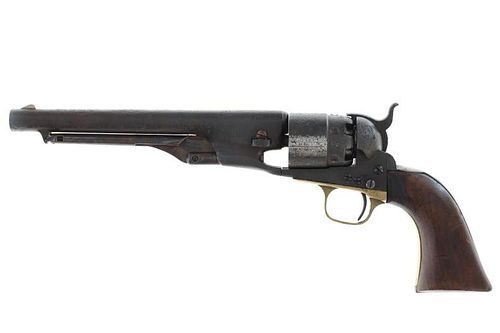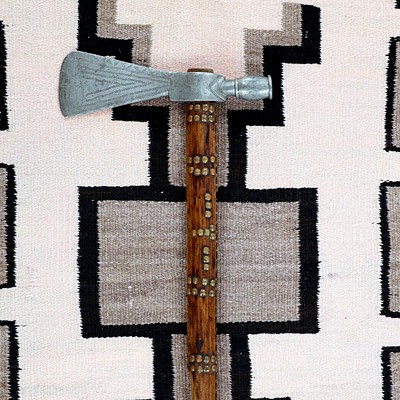Oglala Sioux Crazy Horse owned Colt 1860 Army
Two ways to bid:
- Leave a max absentee bid and the platform will bid on your behalf up to your maximum bid during the live auction.
- Bid live during the auction and your bids will be submitted real-time to the auctioneer.
Bid Increments
| Price | Bid Increment |
|---|---|
| $50 | $10 |
| $100 | $25 |
| $500 | $50 |
| $1,000 | $100 |
| $2,000 | $250 |
| $5,000 | $500 |
| $10,000 | $1,000 |
| $30,000 | $2,500 |
| $50,000 | $5,000 |
| $100,000 | $10,000 |
About Auction
Sep 23, 2023
Join us for this timeless treasure trove of Western History items. From George Armstrong Custer's own S&W and Remington Buffalo Rifle, to historic tomahawks, Navajo rugs, Navajo jewelry and many more pieces from the Frontier and Early American history. North American Auction Company tucker@naabid.com
- Lot Description
The lot features a truly phenomenal, iconic and important Colt Model 1860 Army 44 caliber percussion revolver owned and marked in Togia language by Crazy Horse an Oglala Sioux Shirt Wearer, famed Warrior from the Battle of the Little Bighorn. The firearm is a Colt Model 1860 Army percussion revolver chambered in 44 caliber with a serial number of 4886. The pistol has been examined by Wendell Grangaard from The Guns of History, Inc., in Sioux Falls, South Dakota and was found to be marked in Lakota Togia language as follows: on the left side of the wood grip marked Crazy Horse, the mark for the Grass Dancer warrior society, Oglala (illustration 2); on the right side again the same (illustration 1), on the right side of the frame Crazy Horse and Grass Dancer (society) and the right trigger guard deeper, Crazy Horse (illustration 3); on the left side of the frame again Crazy Horse Grass Dancer (illustration 4); on the right side of the barrel deeply marked Crazy Horse (illustration 5); and the bottom of the frame, “Crazy Horse – Grass Dancer – rode with - Owl Bull” (illustration 6). Crazy Horse (1840-1877) was born in 1840 northwest of Bear Butte by Spring Creek to the elder Crazy Horse and Rattling Blanket Woman. He was originally named Among The Trees at his birth, but later due to his unusual appearance his name was changed to Curly. At around age 15 he had a vison quest speaking of his importance and to take no spoils, wear a small stone behind his ear, use the lightning symbol, only mark his horse with a dusting, and dust his head as well as to not take spoils. He achieved manhood and later his father, Crazy Horse gave Curly his name at which time his father took the name Waglula or Worm, as instructed by the Wakan Horn Chips. In the summer of 1868, Crazy Horse became a Shirt Wearer, being a protector of Paha Sapa (the Black Hills), the home of Wakan Tanka. Crazy Horse formed an elite warrior society known as the Grass Dancers or Peji Waci to protect Paha Sapa, and appointed Black Bear to lead the group. Owl Bull was also a Grass Dancer. During the Indian Wars of circa 1876-1877, Crazy Horse took the Grass Dancers out of Paha Sapa and used them to scout for the Oglala. Crazy Horse fought in the Battle of the Little Bighorn. Later he was killed on September 5, 1877 at the jail at Fort Robinson. In the mid-1970’s Wendell Grangaard was working on a project on Highway 40 along the north side of Battle Creek. At lunch one day one of the Native American Crewmen told Wendell that Crazy Horse, the famous Oglala leader, was buried on the south bank of Battle Creek and that he knew the exact spot that Worm, Crazy Horse’s father had the burial scaffold. The Native worker further told the history that his great-grandfather, Leo Combing was Crazy Horse’s half brother and according to his family history, Crazy Horse was actually buried four times. First was on a low scaffold by the Spotted Tail Agency on a hill east of the agency. Due to his popularity and the notoriety of his good medicine (his vision spoke of not being hit by arrows or bullets) many people wanted his body so they could ride with him to the final battle against the white men. Worm took notice and told the Commander of Fort Robinson, Lieutenant William Clark, that he wanted to move the body. Clark said he would five him a wood coffin to bury Crazy Horse “correctly.” So Worm buried him a second time but it wasn’t long till again, others found out of this location. So Worm then rode to Paha Sapa and erected another burial scaffold by Battle Creek to bury Crazy Horse a third time, to his failure he was forced to move him again, this time he put Crazy Horse’s body on a horse and rode to the Pine Buttes. He took the body and put it in a crack in the wall standing up, then sild some rocks to cover the entrance to the grave. A few days later he asked the crewman to show him the original spot of the scaffold along Battle Creek. The Native crewman showed him and discovered several white beads at the spot and recovered an 1860 Colt Percussion Revolver wrapped in leather, being very rusty with screws and some of the grip eroded. He noted a serial number of 4886 on the gun. The great-grandson of Leo Combing, Crazy Horses half brother, said that the revolver belong to his family and kept the gun. Years later Wendell was noted that someone in the family sold the revolver and he tracked it down. Someone had cleaned most of the rust off, which darkened the metal, replaced the rusted screws and repaired the grips in a few places. The revolver shows a serial number of 4886 on the butt end of the frame, as well as matching on the frame and trigger guard. The front section has a serial number of 5154. There are five replacement screws and the ramrod appears to be a replaced cased hardened example. There are a few inspection A or B marks on the brass. According to Colt the revolver with serial number 4886 was manufactured in 1861, an early example during the American Civil War, put together likely from the factory with the other 5154 serial number piece, as that was manufactured in the same year, 1861; and shares the same amount of wear and pitting. The pistol is accompanied by the photograph illustrations, a map of the Black Hills location of the construction, and a copy of a photo of Crazy Horse enlarged from a drawing by Iron Between The Horse, one of the only known images or likeness of Crazy Horse. Crazy Horse did not believe in taking photographs and his exact likeness is unknown, with this image being only a few known examples. As this firearm was manufacted in 1861 likley to be used during the American Civil War and later presumably found its way with the U.S. men on the Plains. How Crazy Horse came upon the gun or when in his lifetime he owned it is now known, but given his death in 1877, it is possibly this firearm was used during his many famous coups, such as the Battle of the Little Bighorn, not noted in the paperwork. This is an Antique Firearm that does not require an FFL.
- Shipping Info
-
North American Auction Company is proud to announce the opening of our new in-house, full-service shipping department. We have listened to you the customer and will now be handling all outgoing packages in our new shipping department. We are confident this new offering will allow for a smooth transition from auction block to your front step. We have partnered with preferred carriers to ensure a safe, efficient delivery that works best with your schedule. Please allow 14-21 days after complete invoice payment is made to package and ship your purchase. After you are notified of your winning bids from our company and your item invoice is paid in full our new shipping department will contact you. Make sure when signing up with our company that your preferred shipping information is up to date as this information will be used to estimate shipping cost. Once the items have been packaged our team will contact you for shipping payment. Shipping invoices and payment will be completely separately than the items invoice. Please notify the shipping department with any alternate request or instructions at mark@naabid.com or 800-686-4216 ext. 3. For a shipping quote please contact the same information above. PLEASE NOTE a shipping quote price can fluctuate in price. Auction company is not responsible for actual shipping cost being higher than quoted shipping cost. Thank you for trusting North American Auction Co. with your bids and shipping. As our shipping department is brand new please understand that delays can be expected.
-
- Buyer's Premium



 EUR
EUR CAD
CAD AUD
AUD GBP
GBP MXN
MXN HKD
HKD CNY
CNY MYR
MYR SEK
SEK SGD
SGD CHF
CHF THB
THB































